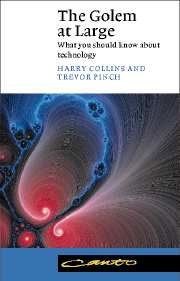Book contents
- Frontmatter
- Contents
- Preface and acknowledgements
- Introduction: the technological golem
- 1 A clean kill?: the role of Patriot in the Gulf War
- 2 The naked launch: assigning blame for the Challenger explosion
- 3 Crash!: nuclear fuel flasks and anti-misting kerosene on trial
- 4 The world according to Gold: disputes about the origins of oil
- 5 Tidings of comfort and joy: Seven Wise Men and the science of economics
- 6 The science of the lambs: Chernobyl and the Cumbrian sheepfarmers
- 7 ACTing UP: AIDS cures and lay expertise
- Conclusion: the golem goes to work
- References and further reading
- Index
6 - The science of the lambs: Chernobyl and the Cumbrian sheepfarmers
Published online by Cambridge University Press: 19 August 2009
- Frontmatter
- Contents
- Preface and acknowledgements
- Introduction: the technological golem
- 1 A clean kill?: the role of Patriot in the Gulf War
- 2 The naked launch: assigning blame for the Challenger explosion
- 3 Crash!: nuclear fuel flasks and anti-misting kerosene on trial
- 4 The world according to Gold: disputes about the origins of oil
- 5 Tidings of comfort and joy: Seven Wise Men and the science of economics
- 6 The science of the lambs: Chernobyl and the Cumbrian sheepfarmers
- 7 ACTing UP: AIDS cures and lay expertise
- Conclusion: the golem goes to work
- References and further reading
- Index
Summary
‘We may be on the eve of a new age of enlightenment. When a scientist says he doesn't know, perhaps there's hope for the future!’ – National Farmers' Union Local Representative during the radioactive sheep crisis.
(Quoted in Wynne, 1996, p. 32)The accident at the Chernobyl nuclear power plant in the Soviet Union on 26 April 1986 is one of the defining moments of the nuclear age. It is the worst nuclear accident ever: a melt-down of the core of a reactor, followed by an explosion and fire releasing tons of radioactive debris into the atmosphere. The accident not only killed nuclear workers and firemen who fought to save the doomed reactor, but also condemned many others who lived under the path of the fallout to illness and premature death or a life of waiting for a hidden enemy. The weather, no respecter of nation states, carried its deadly passenger far and wide.
Fallout over Britain
At first, Britain seemed likely to escape as its predominant weather pattern comes from the west. Traditional British scepticism about weather forecasts was confirmed, however, when six days after the accident, torrential rain and thunderstorms over mountains and uplands deposited a charge of radioactive material. The Chernobyl cloud had undergone a 4,000 kilometre journey with virtually no precipitation until it reached Britain.
- Type
- Chapter
- Information
- The Golem at LargeWhat You Should Know about Technology, pp. 113 - 125Publisher: Cambridge University PressPrint publication year: 2002



